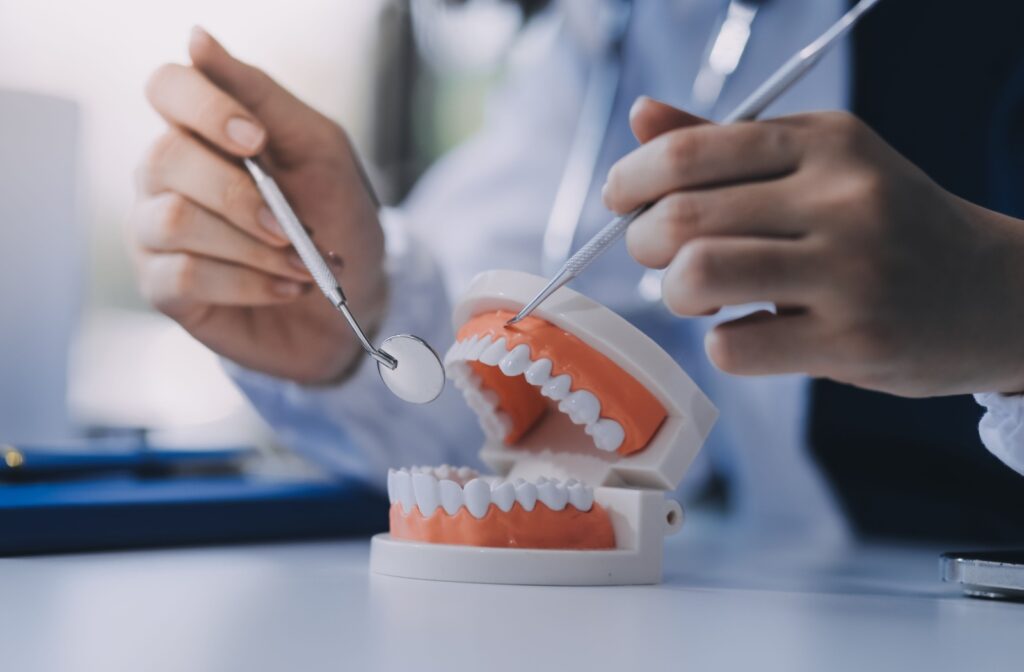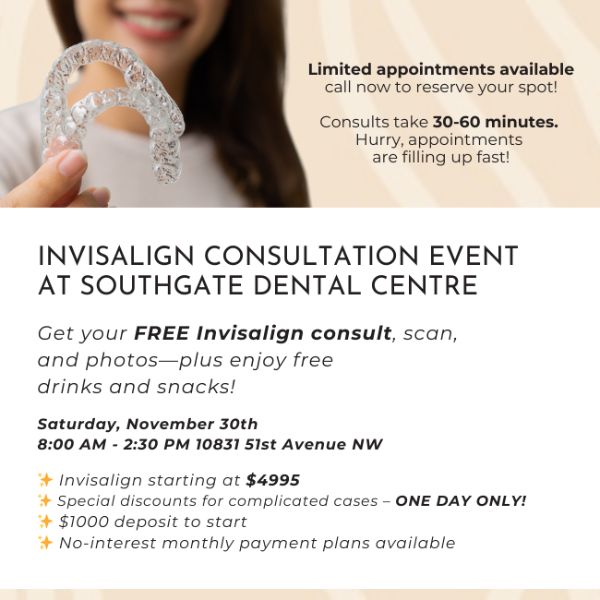If it’s been a while since your last dental cleaning, you might be wondering what happens during your appointment. While many people associate teeth cleaning with just a quick polish and rinse, a professional cleaning is a comprehensive process that includes multiple steps, all designed to protect your oral and overall health.
These steps typically include a medical screening, dental exam, scaling, polishing, flossing, and fluoride treatment. Here’s what you can expect during your next dental cleaning appointment—and why each step matters.
The 7 Steps of a Professional Dental Cleaning
Step 1: Medical Screening
Before anything else, we will conduct a medical history screening. This is a crucial step in maintaining a safe and effective care environment for both patients and staff.
In Alberta, dental practices follow the College of Dental Surgeons of Alberta’s (CDSA) Infection Prevention and Control (IPC) Standards. These guidelines require dental professionals to review your current health status, including any medications you’re taking, chronic conditions, or recent illnesses. This information helps us tailor your care and avoid any procedures that could put your health at risk.
Step 2: Dental Exam
Next, we will perform a dental exam. The goal is to evaluate the overall health of your mouth, catch any early signs of trouble, and provide preventive guidance.
Each tooth is inspected for signs of damage, decay, or gum disease. We may also assess your bite to ensure your teeth and jaw are properly aligned. Beyond your mouth, we also consider your overall health—this could include taking your blood pressure, scanning for oral cancer, and discussing changes in your general medical history.
Step 3: Dental X-rays
Depending on your specific dental findings, we will prescribe the appropriate radiograph at the appropriate time. You may not need x-rays every 6 months, especially if you have been coming regularly and have few dental problems.
However, if you have a history of many dental restorations and/or gum problems, or you have been recently hospitalized or in poor health, radiographs may be required even every 6 months.
X-rays allow for a look between the teeth, beneath the surface, revealing any hidden issues like bone loss, impacted teeth, or decay under fillings.
Our office follows ALARA, which stands for as low as reasonably achievable, when we choose your x-rays—though dental x-rays only make up 0.26% of medical x-rays. We believe in keeping your exposure to a minimum.
Step 4: Hand or Ultrasonic Scaling
Your cleaning typically starts with scaling, which targets plaque and tartar (also called calculus) that accumulates above and below the gumline. Removing tartar is critical because it can lead to inflammation, gum disease, and even tooth loss if left untreated.
Dental offices now use a vibrational hygiene instrument called the Cavitron to make this process more efficient and comfortable. The Cavitron uses ultrasonic technology to break up and remove hardened deposits with gentle vibrations and a stream of water. This method is often preferred because it’s quicker and can be more comfortable for patients. It also allows hygienists to clean more thoroughly in a shorter time. The Cavitron also works better on stains.
The number one reason we use the ultrasonic scaler is that studies have proven it’s better at removing the biofilm around the teeth that causes periodontal disease. Cavitrons are superior to hand scaling for this reason.
Step 5: Polishing
Once the tartar is removed, we’ll polish your teeth using a high-speed handpiece and a special gritty paste. This polishing smooths the tooth surfaces and removes surface stains, leaving your smile brighter and your teeth feeling extra clean.
The type of polish (fine, medium, or coarse grit) is chosen based on your specific needs. Some dental insurance plans do not cover polishing, so it’s a good idea to check your coverage before your visit.
While polishing is safe when done occasionally, too much can abrade your enamel over time. We’ll let you know how often polishing is recommended for you.
Step 6: Flossing
Next comes professional flossing. This step might seem redundant if you floss daily, but it serves a valuable purpose.
We can access spots you may miss, plus we have a vantage point that allows us to see trouble areas—like tight spaces between molars or behind the back teeth. A professional flossing also clears away any remaining plaque or polishing paste from earlier steps.
Afterward, we’ll have you rinse your mouth and prepare your teeth for the final phase of your cleaning.
Step 7: Fluoride Treatment
To wrap up your appointment, we may apply a fluoride treatment to help strengthen your enamel and protect against cavities.
There are two common types of fluoride application:
- Fluoride Gel: This is placed in a soft mouthpiece that rests on your teeth for 1–4 minutes. You will need to avoid eating or drinking for about 30 minutes afterward to get the full effect.
- Fluoride Varnish: Now more commonly used in dental practices, fluoride varnish is painted directly onto your teeth and hardens in the presence of saliva. You can eat or drink right after your appointment, although your teeth may temporarily feel different or appear slightly discoloured. This wears off within hours.
Because fluoride varnish continues working for several hours and provides more long-term protection, it has become the standard in many dental offices.

What Happens Next?
Once your appointment is done, we will likely discuss your oral hygiene routine and offer tips specific to your needs. You may be advised to come back in 6-12 months, or sooner if you have gum disease or other risk factors.
If we spotted anything concerning during the exam or on your x-rays, we may recommend additional appointments for follow-up care, such as fillings, sealants, or orthodontic evaluations.
Ready for Your Next Cleaning?
Now that you know what to expect, you can head into your next teeth cleaning appointment feeling informed and prepared.
At Southgate Dental Centre, we follow the highest standards of care and infection control to ensure your visit is safe, thorough, and stress-free. Ready to schedule your next dental cleaning? Request an appointment today—we’re here to help you smile with confidence.



